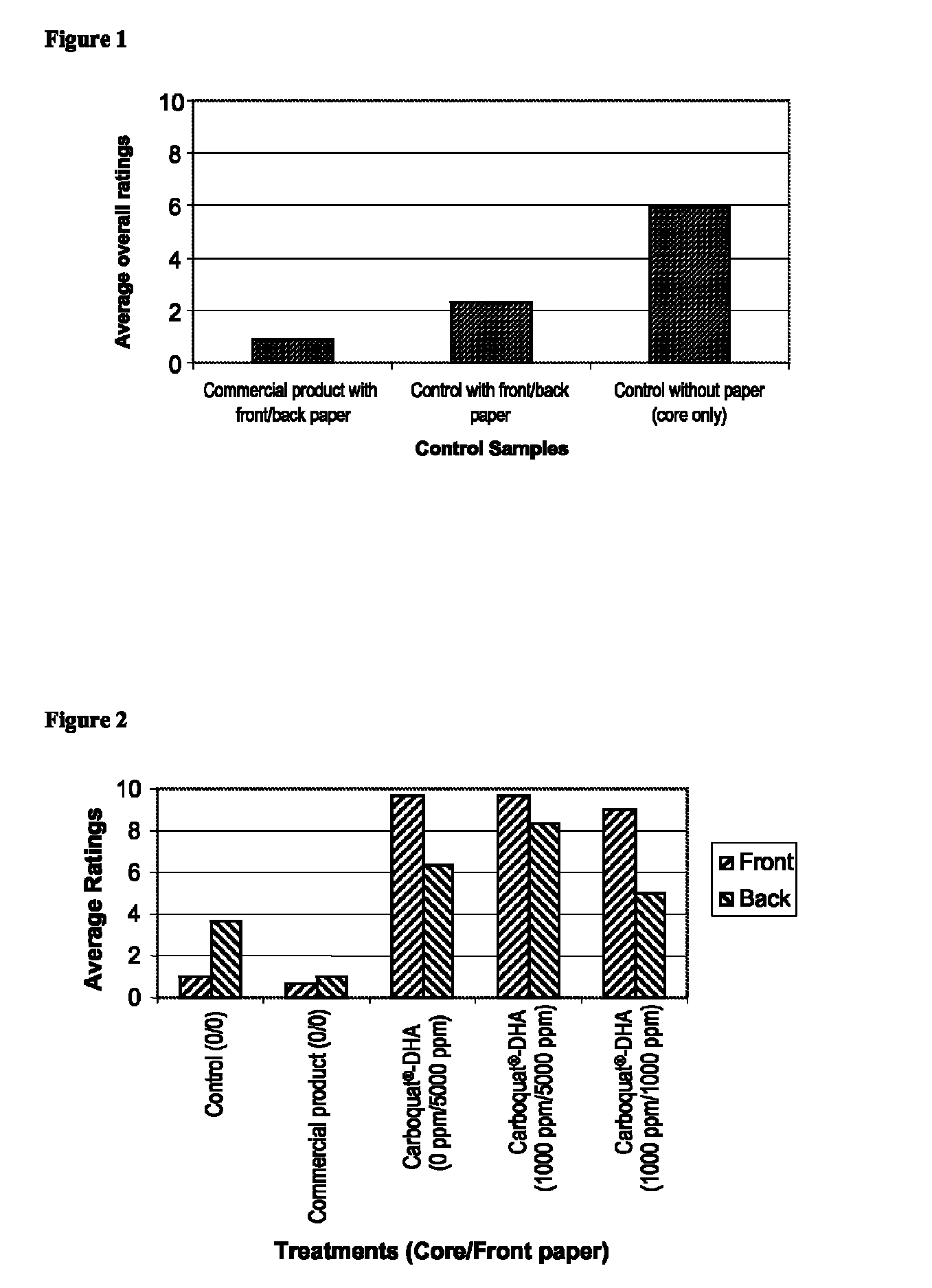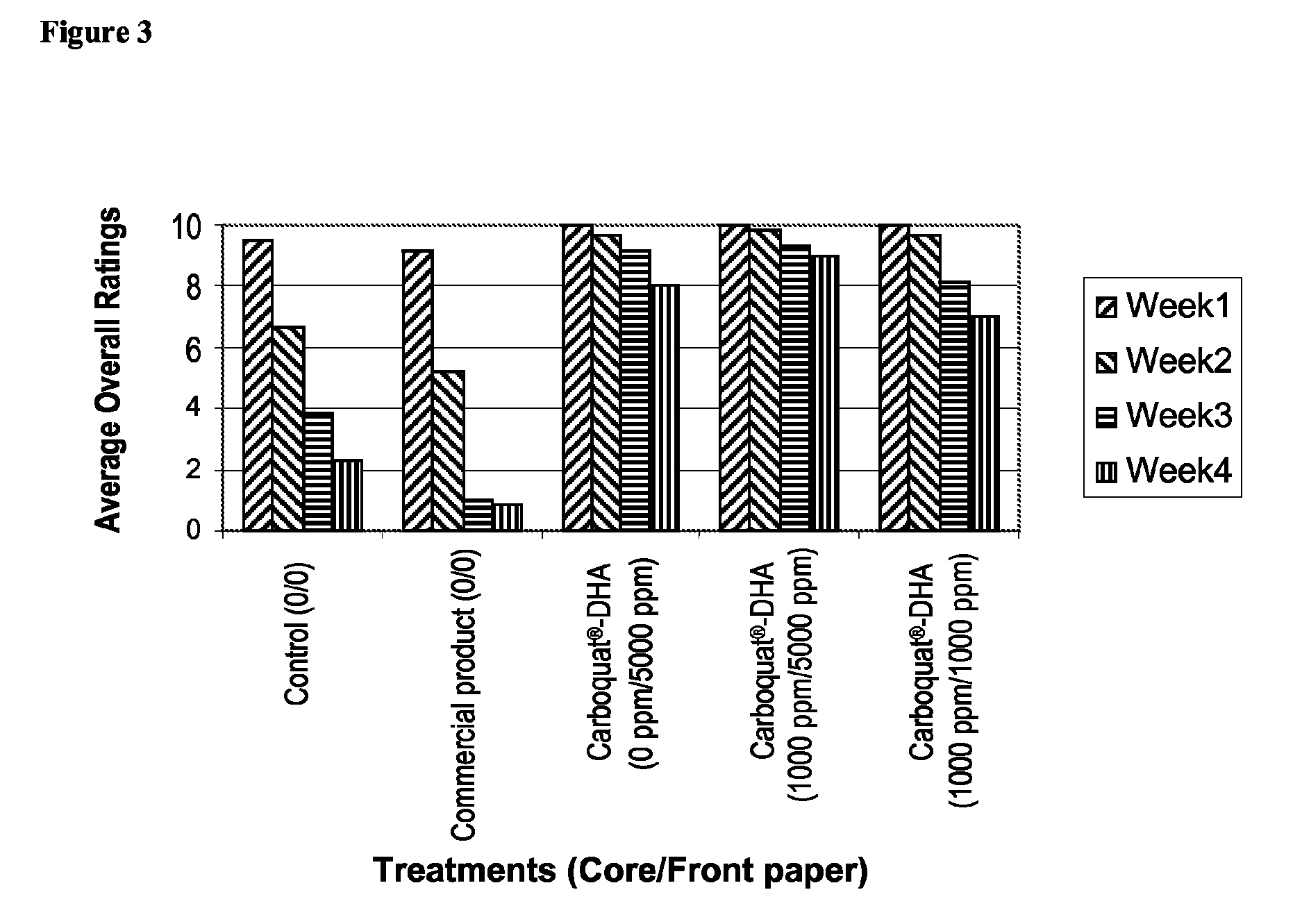Mold-inhibiting method and composition comprising dehydroacetic acid or salt thereof
a technology of dehydroacetic acid and composition, which is applied in the direction of textiles and paper, paper after-treatment, water-setting substance layered products, etc., can solve the problems of mold/mildew growth, deterioration of building materials, and unpleasant odor, so as to reduce or eliminate the effect of reducing or eliminating the growth of mold/mildew and cost-effectiveness
- Summary
- Abstract
- Description
- Claims
- Application Information
AI Technical Summary
Benefits of technology
Problems solved by technology
Method used
Image
Examples
example 1
[0028]Air-dried southern yellow pine wood blocks (8.9×6.35×3.8 cm3) were pressure treated (initial vacuum to −90 kPa, kept at this vacuum condition for 20 min; injected treating solution and introduced air pressure to the treating cylinder to 400 kPa, and kept at this pressure condition for 20 min) with the following prepared formulations:[0029](1) Water[0030](2) 0.33% AC (Monoethanolamine copper carbonate solution)[0031](3) 0.5% ACQ-D1 [0032](4) 0.5% ACQ-D+0.2% Barlox® 122 / DHA 1ACQ-D contains 66.7% copper oxide and 33.3% didecyldimethylammonium chloride2 Barlox® 12 is N-cocoalkyl-N,N-dimethylamine oxide
[0033]The treated wood blocks were placed in plastic sandwich bags immediately after treatment, and the bags were sealed to maintain the moisture content.
[0034]Visual observation of mold growth on the wood blocks was recorded periodically using the following rating system. The samples were evaluated weekly for the first two weeks, and then evaluated every two weeks for the rest of th...
example 2
[0042]Gypsum cuboids (30×40×25 mm3) were made with the addition of the following formulations:[0043]Sodium dehydroacetic acid (Na-DHA): 2500 ppm and 5000 ppm.[0044]Carboquat® 250T3: 2500 ppm and 5000 ppm.[0045]Carboquat® 250T / DHA 10:4 (wt. / wt.): 2500 ppm and 5000 ppm. 3 Carboquat® 250T is an essentially aqueous solution containing approx. 50% of a mixture of carbonate and bicarbonate of didecyldimethylammonium. Carboquat® 250T is available from Lonza Inc., Allendale N.J.
[0046]Glass containers with Sabouraud's Dextrose Agar (SDA) on the bottom were prepared. Freshly-made spore suspensions of A. niger and P. citrinum were spread on the surface of SDA. The gypsum cuboids were air-dried and then placed on the top of the inoculated SDA. The containers were covered by aluminum foil and placed in an incubator with pre-set temperature of 26° C. and relative humidity of 70%. The test was completed at 4 weeks. Visual observation of mold growth on the gypsum cuboids was recorded weekly using t...
example 3
[0050]The mold resistance of gypsum board samples was evaluated using the test ASTM D3273 method.
Methodology:
Preparation of Gypsum Board Samples for ASTM D3273 Test:
[0051]A gypsum slurry was prepared by mixing 722 g of stucco plaster (calcium sulfate hemihydrate) with 463 g of water. The mixture was poured into a rectangular metal tray fully covered with aluminum foil, with the back paper placed on the bottom of the tray. Then the front paper was placed on the top of the slurry. After 9 min, the tray containing the gypsum slurry with front and back paper was placed in an oven with a pre-set temperature of 245° C. for 30 minutes.
[0052]For the Carboquat® 250T or Carboquat® 250T / DHA treated gypsum, each formulation was prepared by adding 1000 ppm of active ingredient(s) to the 463 g of water used for preparing the gypsum slurry. The front paper was treated with the test formulations by brushing. The concentration of active ingredient(s) in the front paper was determined by the concentr...
PUM
| Property | Measurement | Unit |
|---|---|---|
| temperature | aaaaa | aaaaa |
| temperature | aaaaa | aaaaa |
| pressure | aaaaa | aaaaa |
Abstract
Description
Claims
Application Information
 Login to View More
Login to View More - R&D
- Intellectual Property
- Life Sciences
- Materials
- Tech Scout
- Unparalleled Data Quality
- Higher Quality Content
- 60% Fewer Hallucinations
Browse by: Latest US Patents, China's latest patents, Technical Efficacy Thesaurus, Application Domain, Technology Topic, Popular Technical Reports.
© 2025 PatSnap. All rights reserved.Legal|Privacy policy|Modern Slavery Act Transparency Statement|Sitemap|About US| Contact US: help@patsnap.com


